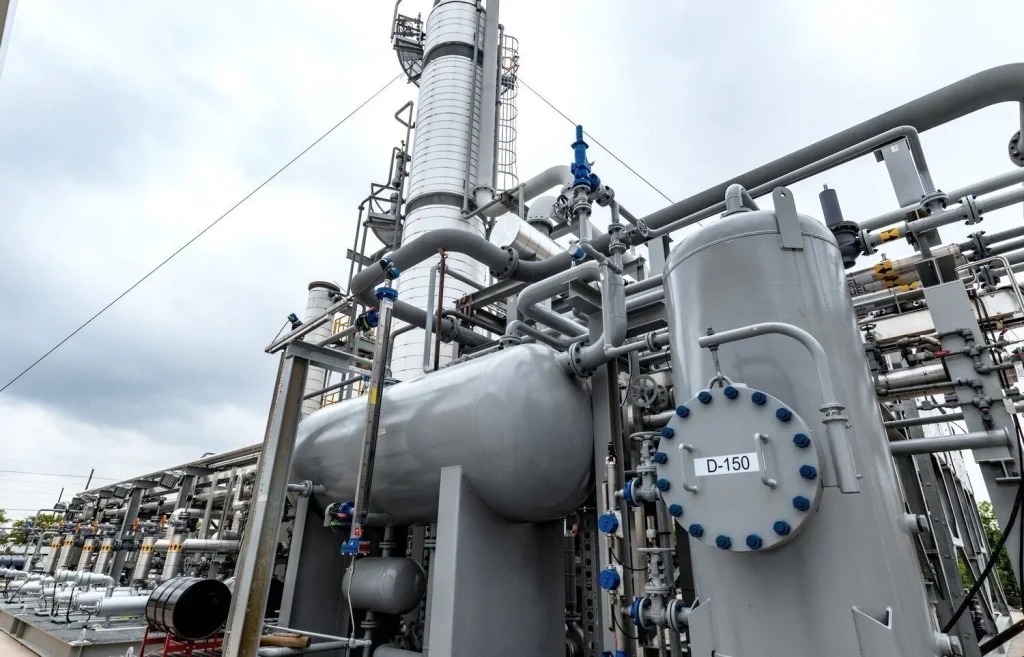How do pressure tanks work? In order to answer this question, we must first know what pressure tanks are.
Pressure vessels are tanks that are usually cylindrical and spherical and are used in various industries to maintain and store liquids or gases at a pressure higher or lower than the environment. And the complex design they have is very sensitive and dangerous, and all standards must be observed in its design.
The importance of pressure vessels:
Pressure vessels are used in various applications, both in industry and in the private sector.
Distillation towers, submarines, reactors, refineries can be mentioned among the applications of pressure vessels.
Pressure tanks for storing liquefied gases such as ammonia, chlorine, propane, butane and LPG can also be mentioned.
In the production and processing of chemicals, pressure vessels are used to carry out chemical reactions at a certain temperature and pressure.
In water purification, pressure tanks are used for water storage and processing.
Various types of pressure tanks
Cylindrical tanks, these tanks have a cylindrical shape and dimensions with two heads, these tanks are used to withstand different pressures and temperatures, and cylindrical tanks can be installed horizontally and vertically, from cylindrical tanks It can be used in the construction of boilers, filter sand and hardener, and storage of liquids.
Another type is spherical tanks, which are made with the dimensions and shape of a dome or sphere, this feature makes the pressure evenly distributed and provides safety from internal and external pressures, the amount of pressure in dome tanks is 10 to 200 pounds
The structure of pressure vessels
These tanks mainly use steel materials and have different components, each of which plays a specific role in their performance and safety.
Body (Shell):
The body of the tank, which may be cylindrical, rectangular or spherical, is designed to withstand internal and external pressures. This body is usually made of carbon steel or stainless steel.
Heads (Ends):
Heads are the end points of the tank that are used to close it. Heads usually include Head and Bottom.
Head:
The head of the cup is the part of the top of the tank and its shape can be a disc (circular plate), ball (semi-ball), or other geometric shapes. This head is connected to the body of the tank.
Bottom:
The lower head is the lowest point of the tank and plays an important role in the stability and safety of the tank. It is usually designed in a dome or rectangular shape.
Nozzles and Flanges:
Slots serve as entry and exit points for liquids, gases, or other materials into the tank. Flanges are used to connect the pipes to the tank and make a tight connection to the gaps.
Tank foundations and supports:
To support the tank and prevent unauthorized deviation, the bases and the end base of the tank are installed. These bases are usually made of steel.
Hoses and connections (Manholes and Connections):
Hoses are used to enter the tank for repairs, cleaning or maintenance. Fittings are used to connect various devices such as sensors, pipes and other equipment to the tank.
Performance of pressure vessels
The working principles of pressure vessels are based on the following two principles:
- Boyle’s Law: This law states that at constant temperature, the product of pressure and volume of a gas is constant. In other words, as the pressure increases, the gas volume decreases and as the pressure decreases, the gas volume increases.
2.Pressure vessels are made of elastic materials. This means that they can deform under pressure and return to their original shape after removing the pressure.
- Before filling the tank, it should be ensured that any defects are healthy, the interior of the tank should be clean and free of any contamination, the desired fluid should be compatible with the body and other components of the tank, first the fluid through the connections on the head The tank is installed, enters the tank, the filling speed should be such that sudden pressure is avoided. During filling, the internal pressure must be constantly monitored by the pressure gauge, emptying the air in the tank is a very important factor that must be completely emptied, not emptying the tank will cause corrosion or rust. After filling the tank, the pressure inside it should be adjusted according to the need, also the safety valve should be opened in case of high pressure and prevent explosion.
- The fluid under pressure is stored inside the tank. In the next step, the pressure inside the tank is monitored by a pressure gauge. If needed, the pressure inside the tank is adjusted by the safety valve.
- Fluid transfer: When the outlet valve of the tank is opened, the fluid under pressure leaves the tank, as the fluid leaves the tank, the pressure inside the tank decreases. According to Boyle’s law, as the pressure decreases, the volume of the fluid increases. The elasticity of the tank body makes the tank return to its original shape.
Conclusion:
Pressure vessels are very useful equipment in various industries. These tanks bring many advantages such as safe storage of fluids, reduced costs and improved efficiency.
Petrosazeh company, a producer of all kinds of fixed equipment for the oil and gas industry, spherical tanks, cylindrical tanks, etc., with many years of activity in this field, has gone bankrupt with many large companies and petrochemical companies, and has always tried to increase its Your products will take a big step towards the development of our beloved country.


